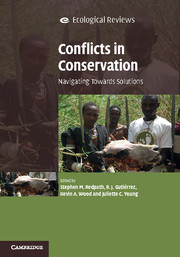Book contents
- Frontmatter
- Dedication
- Contents
- List of contributors
- Foreword by Georgina Mace
- Acknowledgements
- Part I Introduction to conservation and conflict
- PART II Contrasting disciplinary approaches to the study of conflict in conservation
- 3 The value of ecological information in conservation conflict
- 4 Environmental history and conservation conflicts
- 5 The political ecology of conservation conflicts
- 6 Understanding conservation conflicts: an economic perspective
- 7 Anthropological approaches to conservation conflicts
- 8 Law and conservation conflicts
- 9 The relevance of psychology to conservation conflicts
- 10 Conservation conflicts: ethical issues
- 11 A view from sociology: environmental movement mobilisation over old-growth temperate rainforests in British Columbia
- 12 Peace research and conservation conflicts
- 13 Linking conflict and global biodiversity conservation policies
- Part III Approaches to managing conflicts
- Index
- Plate Section
- References
7 - Anthropological approaches to conservation conflicts
from PART II - Contrasting disciplinary approaches to the study of conflict in conservation
Published online by Cambridge University Press: 05 May 2015
- Frontmatter
- Dedication
- Contents
- List of contributors
- Foreword by Georgina Mace
- Acknowledgements
- Part I Introduction to conservation and conflict
- PART II Contrasting disciplinary approaches to the study of conflict in conservation
- 3 The value of ecological information in conservation conflict
- 4 Environmental history and conservation conflicts
- 5 The political ecology of conservation conflicts
- 6 Understanding conservation conflicts: an economic perspective
- 7 Anthropological approaches to conservation conflicts
- 8 Law and conservation conflicts
- 9 The relevance of psychology to conservation conflicts
- 10 Conservation conflicts: ethical issues
- 11 A view from sociology: environmental movement mobilisation over old-growth temperate rainforests in British Columbia
- 12 Peace research and conservation conflicts
- 13 Linking conflict and global biodiversity conservation policies
- Part III Approaches to managing conflicts
- Index
- Plate Section
- References
Summary
Conservation is a relational practice. Thus, it is commonly supposed that nature conservation is primarily concerned with nature, particularly nature in the sense of that which is external to human society. Following this model, which is somewhat redolent of the ‘Platonic cave’ (i.e. the conceptualisation of society as existing in the political world of ‘the cave’ away from the external world of nature, which can only come to be known via the specialist techniques of science or philosophy; see Latour, 2004), conservation has been dominated by the natural sciences, particularly ecology, in assessing the work that needs doing and how best it might be achieved. The potential contribution of the social sciences has arguably been perceived as limited to providing insights into the ‘human dimensions’ for example, by helping to incorporate the interests of ‘local people’ and other ‘stakeholders’ into the management plans that have already been developed by conservationists. They have dealt with the politics of ‘the cave’ and the natural scientists have ventured into the world of nature to find out what is going on there before returning to society to explain what needs to be done.
While this is an illustrative simplification, social science has largely been subservient to natural science in the development of conservation. The reasons for this, I argue, arise from conservation being conceptualised as the management of a detached nature that is understood by means of natural science. When one analyses the practice of conservation, it soon becomes clear that it is an activity that is less about people mastering a detached nature than about assessing how best to regulate human activities in relation to their environment. This shift in emphasis, from conservation as an understanding of nature and its management to conservation as primarily about human activity in relation to the environment, still demands the skills of natural scientists, but places the social sciences much more at the heart of conservationist endeavours.
- Type
- Chapter
- Information
- Conflicts in ConservationNavigating Towards Solutions, pp. 94 - 107Publisher: Cambridge University PressPrint publication year: 2015
References
- 3
- Cited by



